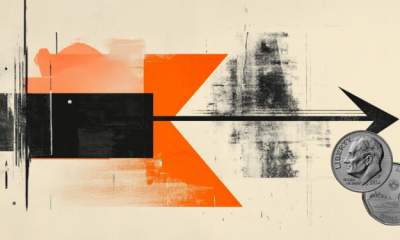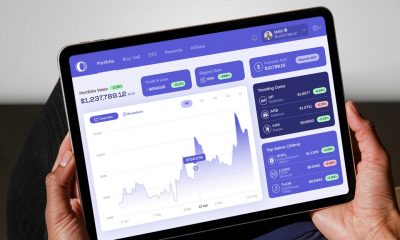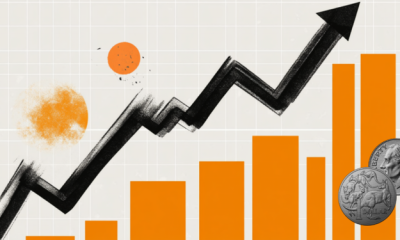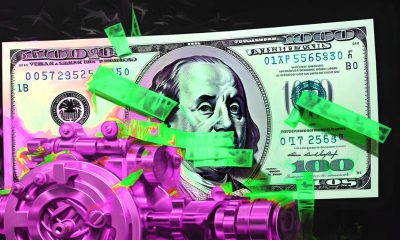![S&P 500, AAPL, AMZN, NVDA, TSLA, GOOGL, BRK.B, SQ, META, NFLX and more [Video]](https://dripp.zone/news/wp-content/uploads/2022/10/SP-500-AAPL-AMZN-NVDA-TSLA-GOOGL-BRKB-SQ-META.jpg)
![S&P 500, AAPL, AMZN, NVDA, TSLA, GOOGL, BRK.B, SQ, META, NFLX and more [Video]](https://dripp.zone/news/wp-content/uploads/2022/10/SP-500-AAPL-AMZN-NVDA-TSLA-GOOGL-BRKB-SQ-META-560x498.jpg)
others
Dow Jones Average expects volatility on Quad Witching Day – Crypto News
- June 16 is Quad Witching Day as quarterly and monthly options and futures expire.
- The Dow Jones index should experience higher than average volatility on Quad Witching Day.
- The Michigan Consumer Sentiment Index, released on June 16, is expected to be positive.
- The DJIA is trading within the 34,250 to 34,600 resistance band.
Friday, June 16, is the day you’ve all been waiting for: Quad Witching Day. Stock index futures, stock index options, stock options, and single-stock futures derivatives contracts all expire at the closing of Friday’s session, so volatility and higher volumes are to be expected. The Dow Jones Industrial Average (DJIA) rebounded on Thursday to close up 1.26%. This was its largest gain since June 2. The large-cap index has been steadily reducing the distance between it and the 1-year high in recent weeks.
At the time of writing in Friday’s premarket, Dow futures are down 0.03%, while S&P 500 and NASDAQ futures are marginally green.
Dow Jones Index News: Quad witching to boost volatility
If you’re a nerd, you’re probably screaming about Quad Witching Day no longer being extant. That is true. What is popularly called Quad Witching since 2020 has been Triple Witching. This is because single-stock futures ended in the US markets at that time. However, they do still trade outside the US.
However, index options, index futures and stock options still expire once every quarter, and this quarter that day is June 16. As traders and institutional investors close out many of their options and derivatives contracts, or roll them into new contracts, typically these Quad (Triple) Witching days offer higher levels of overall volumes in the market. These high volumes can lead to higher-than-average volatility as well. To be sure, much of this volume is in the options and futures markets, not the normal equity market.
Still, an index like the Dow Jones Industrial Average still often witnesses some gyration in price action. During the last Quad Witching Day on March 17, the Dow dropped 1.19%.
Michigan Consumer Sentiment Index expected to read positively for June
Also on Friday at 14 GMT, thus following the opening bell, the University of Michigan is set to release its preliminary figure for consumer confidence in June. The survey tries to determine if the average US consumer feels confident enough about their financial situation and the broader labor market to spend the money. Since about 70% of the US economy is driven by consumer spending, economists and market participants alike view the Michigan Consumer Sentiment Survey as a means of gauging the health and direction of the economy.
Consensus for this month’s index is 60, which is above and thus a better reading than May’s 59.2 reading. Higher numbers are better than lower numbers, and higher numbers generally boost the value of the US Dollar, May’s reading beat expectations for 57.7.
Dow Jones FAQs
What is the Dow Jones?
The Dow Jones Industrial Average, one of the oldest stock market indices in the world, is compiled of the 30 most traded stocks in the US. The index is price-weighted rather than weighted by capitalization. It is calculated by summing the prices of the constituent stocks and dividing them by a factor, currently 0.152. The index was founded by Charles Dow, who also founded the Wall Street Journal. In later years it has been criticized for not being broadly representative enough because it only tracks 30 conglomerates, unlike broader indices such as the S&P 500.
What factors impact the Dow Jones Industrial Average?
Many different factors drive the Dow Jones Industrial Average (DJIA). The aggregate performance of the component companies revealed in quarterly company earnings reports is the main one. US and global macroeconomic data also contributes as it impacts on investor sentiment. The level of interest rates, set by the Federal Reserve (Fed), also influences the DJIA as it affects the cost of credit, on which many corporations are heavily dependent. Therefore, inflation can be a major driver as well as other metrics which impact the Fed decisions.
What is Dow Theory?
Dow Theory is a method for identifying the primary trend of the stock market developed by Charles Dow. A key step is to compare the direction of the Dow Jones Industrial Average (DJIA) and the Dow Jones Transportation Average (DJTA) and only follow trends where both are moving in the same direction. Volume is a confirmatory criterion. The theory uses elements of peak and trough analysis. Dow’s theory posits three trend phases: accumulation, when smart money starts buying or selling; public participation, when the wider public joins in; and distribution, when the smart money exits.
How can I trade the DJIA?
There are a number of ways to trade the DJIA. One is to use ETFs which allow investors to trade the DJIA as a single security, rather than having to buy shares in all 30 constituent companies. A leading example is the SPDR Dow Jones Industrial Average ETF (DIA). DJIA futures contracts enable traders to speculate on the future value of the index and options provide the right, but not the obligation, to buy or sell the index at a predetermined price in the future. Mutual funds enable investors to buy a share of a diversified portfolio of DJIA stocks thus providing exposure to the overall index.
Dow Jones forecast
The Dow Jones index thrust its way this week into the resistance zone that spans 34,250 to 34,600. Closing at 34,408 on Thursday means the Dow index could require a few more sessions to break above the top of the resistance zone. Of course, the index has only traded above the top of this resistance zone one time in the past year. That was December 13, 2022, when a quick surge to 34,712 flopped, and the index promptly sold off all the way to 33,890 by the end of that session.
This history puts the DJIA in a precarious position then at the moment. Bulls want to see a new 1-year high above 34,712 but know this region commonly launches month-long downtrends. If bulls can make it through this thicket to a new 1-year high, then the next challenge will be the 35,200 to 35,750 resistance band that experienced plenty of price action and volume between October 2021 and April 2022.
DJI daily chart
-

 Technology1 week ago
Technology1 week agoMeet Matt Deitke: 24-year-old AI whiz lured by Mark Zuckerberg with whopping $250 million offer – Crypto News
-
Technology5 days ago
Binance to List Fireverse (FIR)- What You Need to Know Before August 6 – Crypto News
-

 Technology1 week ago
Technology1 week agoIs AI causing tech worker layoffs? Thats what CEOs suggest, but the reality is complicated – Crypto News
-

 Business1 week ago
Business1 week agoChase Launches $4 Million Grant Program as Restaurants Struggle – Crypto News
-

 Cryptocurrency1 week ago
Cryptocurrency1 week agoXRP inflows drop 95% since July spike, while Chaikin data signals possible rally – Crypto News
-
others1 week ago
XRP NIGHT Token Airdrop: Snapshot, Claim Date and What to Expect? – Crypto News
-

 Blockchain1 week ago
Blockchain1 week agoBank of America Sees Interest in Tokenization of Real-World Assets – Crypto News
-

 Blockchain7 days ago
Blockchain7 days agoAltcoin Rally To Commence When These 2 Signals Activate – Details – Crypto News
-
others1 week ago
Breaking: Strategy Files $4.2 Billion STRC Offering To Buy More Bitcoin – Crypto News
-

 Blockchain1 week ago
Blockchain1 week agoSEC Crypto ETFs Ruling Brings Structural Fix, Not Retail Shakeup – Crypto News
-
Business1 week ago
Breaking: Solana ETFs Near Launch as Issuers Update S-1s With Fund Fees – Crypto News
-
Cryptocurrency6 days ago
Cardano’s NIGHT Airdrop to Hit 2.2M XRP Wallets — Find Out How Much You Can Get – Crypto News
-
others1 week ago
Ripple Swell 2025: Top Speakers and Panelists to Watch this November – Crypto News
-

 Technology1 week ago
Technology1 week agoOppo K13 Turbo series confirmed to launch in India with in-built fan technology: Price, specs and everything expected – Crypto News
-
Business1 week ago
Bitpanda Co-Founder & Co-CEO Paul Klanschek Steps Down as Firm Eyes Frankfurt IPO – Crypto News
-
Business1 week ago
Stablecoins Won’t Boost Treasury Demand, Peter Schiff Warns – Crypto News
-

 De-fi1 week ago
De-fi1 week agoWhite House Crypto Report Recommends Expanding CFTC’s Role in Crypto Regulation – Crypto News
-
Technology1 week ago
Coinbase to Offer Tokenized Stocks and Prediction Markets in U.S. – Crypto News
-

 others1 week ago
others1 week agoCanadian Dollar under pressure amid weak GDP, Trump tariff threat, and strong US data – Crypto News
-
Technology6 days ago
Beyond Billboards: Why Crypto’s Future Depends on Smarter Sports Sponsorships – Crypto News
-

 Technology1 week ago
Technology1 week agoCoinbase exchange targets alleged cybersquatter in lawsuit – Crypto News
-

 Cryptocurrency1 week ago
Cryptocurrency1 week agoCoinbase and JPMorgan Chase partner for crypto integration – Crypto News
-

 De-fi1 week ago
De-fi1 week agoCourt Overturns Fraud Conviction of OpenSea’s Nate Chastain – Crypto News
-

 Technology1 week ago
Technology1 week agoBig Tech’s Big Bet on AI Driving $344 Billion in Spend This Year – Crypto News
-
Cryptocurrency1 week ago
CME XRP Futures Hit Record Highs in July Amid ETF Approval Optimism – Crypto News
-

 Cryptocurrency7 days ago
Cryptocurrency7 days agoStablecoins Are Finally Legal—Now Comes the Hard Part – Crypto News
-

 Cryptocurrency7 days ago
Cryptocurrency7 days agoTron Eyes 40% Surge as Whales Pile In – Crypto News
-

 Cryptocurrency6 days ago
Cryptocurrency6 days agoEthereum Hits Major 2025 Year Peak Despite Price Dropping to $3,500 – Crypto News
-
Business4 days ago
Analyst Spots Death Cross on XRP Price as Exchange Inflows Surge – Is A Crash Ahead ? – Crypto News
-

 Technology4 days ago
Technology4 days agoOppo K13 Turbo, K13 Turbo Pro to launch in India on 11 August: Expected price, specs and more – Crypto News
-

 Cryptocurrency1 week ago
Cryptocurrency1 week agoAltcoins update: Dogecoin and Injective signal recoveries as Ethereum eyes $4,000 – Crypto News
-
Business1 week ago
Breaking: CBOE Files For Rule Change To List Crypto ETFs Without SEC Approval – Crypto News
-

 others1 week ago
others1 week agoGold slides below $3,300 as traders await Fed policy decision – Crypto News
-

 others1 week ago
others1 week agoGold slides below $3,300 as traders await Fed policy decision – Crypto News
-
Business1 week ago
Breaking: SEC Launches “Project Crypto” To Enable Tokenization of U.S. Markets – Crypto News
-
![WBC Elliott Wave analysis and Elliott Wave forecast [Video]](https://dripp.zone/news/wp-content/uploads/2025/01/WBC-Elliott-Wave-analysis-and-Elliott-Wave-forecast-Video-400x240.jpg)
![WBC Elliott Wave analysis and Elliott Wave forecast [Video]](https://dripp.zone/news/wp-content/uploads/2025/01/WBC-Elliott-Wave-analysis-and-Elliott-Wave-forecast-Video-80x80.jpg) others1 week ago
others1 week agoCan the record-breaking rally last? – Crypto News
-

 Technology1 week ago
Technology1 week agoSolana DEX volume dips 20% after co-founder slams meme coins – Crypto News
-

 Technology1 week ago
Technology1 week agoTim Cook confirms Apple will ramp up AI spending, ‘open’ to acquisitions – Crypto News
-

 Technology1 week ago
Technology1 week agoOppo K13 Turbo series confirmed to launch in India with in-built fan technology: Price, specs and everything expected – Crypto News
-

 Blockchain1 week ago
Blockchain1 week agoStrategy Expands STRC Offering Twice in One Week – Crypto News
-
Technology7 days ago
Will The First Spot XRP ETF Launch This Month? SEC Provides Update On Grayscale’s Fund – Crypto News
-

 Technology7 days ago
Technology7 days agoAmazon Great Freedom Sale deals on smartwatches: Up to 70% off on Samsung, Apple and more – Crypto News
-

 Blockchain6 days ago
Blockchain6 days agoXRP Must Hold $2.65 Support Or Risk Major Breakdown – Analyst – Crypto News
-

 Blockchain6 days ago
Blockchain6 days agoXRP Must Hold $2.65 Support Or Risk Major Breakdown – Analyst – Crypto News
-
Business6 days ago
Is Quantum Computing A Threat for Bitcoin- Elon Musk Asks Grok – Crypto News
-

 Technology6 days ago
Technology6 days agoElon Musk reveals why AI won’t replace consultants anytime soon—and it’s not what you think – Crypto News
-

 Technology5 days ago
Technology5 days agoGoogle DeepMind CEO Demis Hassabis explains why AI could replace doctors but not nurses – Crypto News
-

 Cryptocurrency4 days ago
Cryptocurrency4 days agoLido Slashes 15% of Staff, Cites Operational Cost Concerns – Crypto News
-

 De-fi4 days ago
De-fi4 days agoTON Sinks 7.6% Despite Verb’s $558M Bid to Build First Public Toncoin Treasury Firm – Crypto News
-
Blockchain4 days ago
Shiba Inu Team Member Reveals ‘Primary Challenge’ And ‘Top Priority’ Amid Market Uncertainty – Crypto News












